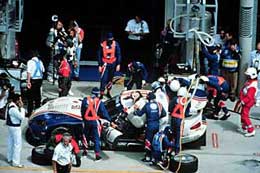

Racing Terms
Some terms are explained here that are found throughout the manual.
Apex
This is the transtion point between your entrance and exit in every turn. The apex is the area on the bend where your car touches the most inside part of the curve it is rounding. There are two common modes of apexing in racing. The early apex comes before the geometric apex (the symmetrical point where a curve can be divided), while the late apex comes after.
Braking Point
Before you enter most curves, there is a critical point where you usually use your brakes - sometimes all you have to do is ease up on the throttle. This is what racers commonly call the braking point.
Contact Patch
When you are cruising down the track, a small part of each tire is grabbing the road. The small area of rubber touching the asphalt is called the contact patch. As common sense goes, the more tire you have hugging the road, the better your car will handle.
Corner
The corner is simply the bend in the road. In the world of racing lingo, it can also refer to the wheel, tire, and suspension parts at each corner of the car.
Downforce
Downforce is the amount of exertion air pressure has on specific areas of your car. It is measured in pounds.
Exit Point
The point at the exit of a corner (usually a way down the ensuing straight) where the lateral G-forces on the chassis reach zero. In other words, the point where the corner is no longer affecting the chassis.
G-Force
Gravitational forces are constantly being exerted upon you and the world you live in. At this very instant, gravity is holding you to the earth. But let's forget about the compexities of Newton and Einstein for a minute here. Things, after all, are really simple.
For starters, we measure gravitational forces in a convenient manner. For instance, you are living in a 1 G world, the G-Forces upon this planet.
Racecars are effected by G-Forces. Although you will be racing in 1 G conditions, high speeds create tremendous effects upon cars. One primary cause is responsible for the centripetal and centrifugal forces that effect your car's performance: inertia. This is the tendency of an object to remain in it's given path. When cruising through corners, it is this principle that creates the critical G-Forces that racecar drivers are concerned about.
Line
This is a racing term that refers to the idea path around a track. It is an imaginary line (not the one on the road) that represents the most efficient and fastest way around the course. Every venue has a line. It is the job of the driver to find this ideal path and to utilize it.
Loading
We're not talking about the installation of your software here. Loading is part of the racing jargon that refers to the G-Forces (and downforce) exerted upon your car in each turn. For example, when the right front tire of your Viper is carrying most of your car's weight as it enters a left-hand bend, the corner is said to be loaded.
Oversteering
If a car's rear tires are sliding toward the outside of a corner at a quicker rate than the front tires, the car is oversteering. It can be caused by a number of things - from tight rear shocks to just plain ol' driving inexperience.
Slip Angle
Another reference to phenomena in the corners. The difference between the direction you are steering and the actual direction your car is traveling is calculated as the slip angle. When racing, high speeds will cause the tires to slip some in the curves. This is illustrated in life and in sim racing with the squealing tires and skid marks. Of course, if you are going to be competitive some sliding is unavoidable. As the great Parnelli Jones once said, "If your car is under control, you're to slow".
Throttle
The throttle is just another word for the accelerator; they are one and the same thing. A popular phrase within the world of racing is "to breathe the throttle". This is, simply, letting off the throttle momentarily, only to press it again. This motion between your foot and the throttle is called this because of it's obvious similarity to the pressing in and out of air by the lungs.
Turn-In Point
Part of the three-step process of taking a curve, the turn-in point is the place where you begin turning the wheel into the bend. Think of it as the very opposite of the exit point. Here, you will begin slowing down and entering the curve, whereas with the exit point you step on the gas and enter the straightaway. Often the braking point and turn-in point overlap.
Trail Braking
Most pre-corner braking takes place in a straight line. It's just easier to control a Viper that way. Many experienced drivers, however, will brake a tad too late to slow before they turn into the corner. In this instance they will keep a light pressure on the brake (called trail braking) as they enter the corner.
Understeer
If a car's front tires are sliding towards the outside of a corner at a quicker rate than the rear tires, the car is understeering. It can be caused by a number of things - from soft rear shocks to insufficient downforce at the front of the car.
The Manual | Chassis | Align | Drivetrain | Aero | Jim's Setup Tips

